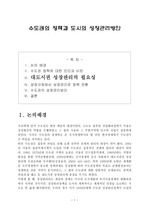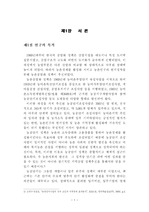

-
미리보기
서지정보
· 발행기관 : 한국사회사학회
· 수록지 정보 : 사회와역사(구 한국사회사학회논문집) / 127호 / 219 ~ 254페이지
· 저자명 : 김백영
초록
서울을 중심으로 한 수도권은 ‘한강의 기적’으로 표상되는 한국의 압축 근대화의중핵 지대로서 20세기 후반 한국사회 특유의 압축 도시화를 대표하는 지역이다. 이 글에서는 1990년대 수도권 광역대도시권 형성의 초기 국면에 주목하여 이 시기한국 도시성의 변화 양상을 다음 세 가지 측면에 초점을 맞춰 살펴보았다. 첫째는도시정치 레짐 차원의 변화로, 이 시기 서울시에서는 정도(定都) 600년 기념사업과역사 바로세우기(구 조선총독부 청사 철거)사업이라는 두 가지 기념비적인 관 주도적 사업과 더불어 지방자치제 시행에 따라 다양한 정책적 전환이 모색되었다. 하지만 관선에서 민선으로의 제도적 전환에도 불구하고 도시정치 레짐은 이전 시기의관성에서 쉽사리 벗어나지 못하는 연속성이 두드러졌다. 둘째는 물리적 공간·환경 차원의 변화다. 1990년대는 수도권 제1기 신도시 개발과 더불어 도시개발의광역화 현상이 전국적으로 확산된 시기로 대규모 아파트단지의 생활환경 개선 및수도권 교통대란 해소 등 도시인프라 확충 문제가 시급한 사회문제로 대두되었다. 셋째는 도시사회의 문화적·의식적 차원의 변화다. 이 시기는 소득수준과 교육수준 향상과 더불어 아파트 주거문화를 비롯한 대도시 신흥 중산층 생활양식이 확산되면서 중산층 소비문화 현상이 크게 늘어난 시기이자 성수대교 붕괴나 삼풍백화점 붕괴와 같은 외상적 사건이 시민의식에 큰 충격을 던진 시기이기도 하다. 이러한 변화는 과거 권위주의 정부에 의해 주도된 도시개발의 관행에 대한 성찰의 계기를 제공했지만, 이후 수도권 신도시 개발과정에서 대자본이 주도하는 시장 주도적개발방식은 더욱 확산되는 경향이 나타났다. 이처럼 1990년대는 민주화 이후 사회체제의 일시적 이완과 문화적 일탈이 나타난 시기임과 동시에 시민사회의 성장과더불어 환경문제 등 새로운 도시문제에 대한 대응책이 암중모색되는 시기였다. 1980년대의 경제호황과 도시성장을 계기로 형성되기 시작한 수도권 거대도시권은1997년 외환위기 이후 신자유주의적 도시화와 계층간 양극화라는 새로운 변화를맞게 된다. ‘87년체제’의 정착과 ‘97년체제’의 도입 사이에 수도권이 경험한 도시성의 전환은 20세기말 한국 도시성의 과도기적 변화 양상을 다차원적 역동성으로 보여준다.영어초록
It is a well-known fact that the Seoul metropolitan area is the core area of Korea’s compressed modernization, represented as the “miracle of the Han River.” This area is a region which shows the unique compressed urbanization of Korean society in the late 20th century. Focusing on the process of Seoul’s metropolitanization in the 1990s, this article investigates three aspects of Korean urbanism and its changing patterns during this period. The first is the change of urban politico-administrative regime caused by the enforcement of the local autonomy act. Reflecting the politico-societal achievements of democratization of the so-called ‘the regime of 1987,’ the method of election of regional government heads has changed in early the 1990s. However, the practice of the authoritarian era in the decision-making process of urban politics persisted. The second is the change in urban spatial and environmental dimensions. In the 1990s, the development of new cities in the metropolitan area and the development of urban regions spread across the country, and urban infrastructure issues such as the mass transportation network connecting Seoul and surrounding satellite cities into one metropolitan area emerged as urgent social requirements. The third is the change in the level of urban culture and civic consciousness. During this period, Seoul had several historical breaks that differentiated it from the previous periods: the government-led projects (e.g., the 600th anniversary of the capital’s designation and the demolition of Japanese colonial government building) and the traumatic incidents (e.g., the collapse of Seongsu Bridge and the collapse of Sampoong Department Store). In addition, rising income and education levels and the emerging urban middle class in megacity areas led to higher a culture of urban mass consumption. While these changes provided an opportunity to reflect and improve the past practices of urban development, the authoritarian government’s capital-driven, market-oriented development also pushed the spread into new cities and beyond the Seoul metropolitan area. Despite the temporary relaxation and anomie of the urban governmental regime after the political democratization, civil society’s growth continues to alleviate new urban and environmental problems. The 1980s Seoul metropolitan area was destined to face a neoliberal change in urbanism heightened by socio-economical polarization after the 1997 financial crisis. As such, the great transformation of Korean urbanism between the ’88 Seoul Olympic Games and the 1997 financial crisis has taken place primarily in the Seoul metropolitan area. These findings underline Korean urbanism’s multidimensional dynamism during the transitional period between democratization and neo-liberalization.참고자료
· 없음태그
-
자주묻는질문의 답변을 확인해 주세요

꼭 알아주세요
-
자료의 정보 및 내용의 진실성에 대하여 해피캠퍼스는 보증하지 않으며, 해당 정보 및 게시물 저작권과 기타 법적 책임은 자료 등록자에게 있습니다.
자료 및 게시물 내용의 불법적 이용, 무단 전재∙배포는 금지되어 있습니다.
저작권침해, 명예훼손 등 분쟁 요소 발견 시 고객센터의 저작권침해 신고센터를 이용해 주시기 바랍니다. -
해피캠퍼스는 구매자와 판매자 모두가 만족하는 서비스가 되도록 노력하고 있으며, 아래의 4가지 자료환불 조건을 꼭 확인해주시기 바랍니다.
파일오류 중복자료 저작권 없음 설명과 실제 내용 불일치 파일의 다운로드가 제대로 되지 않거나 파일형식에 맞는 프로그램으로 정상 작동하지 않는 경우 다른 자료와 70% 이상 내용이 일치하는 경우 (중복임을 확인할 수 있는 근거 필요함) 인터넷의 다른 사이트, 연구기관, 학교, 서적 등의 자료를 도용한 경우 자료의 설명과 실제 자료의 내용이 일치하지 않는 경우
“사회와역사(구 한국사회사학회논문집)”의 다른 논문도 확인해 보세요!
-
민주화프레임과 학생운동네트웍, 그리고 5·18민중항쟁 — 1980년 전남대 학생운동 사례를 중심으로 34 페이지
이 연구의 질문은 아래와 같다. 첫째, 1980년 봄에 있었던 전남대 학생운동과5·18민중항쟁의 상호관련성은 있는가? 둘째, 5·18민중항쟁에서 전남대 학생들은 어떤 활동을 하였는가? 셋째, 학생들이 생명의 위협에도 불구하고 5·18민중항쟁에 참여했다면, 그것을 가능케 한 요인은 무엇인가? 연구결과는 다음과 같다. 첫째, 1980년 봄의 전남대 학생운동은 .. -
박정희 정권의 사회 개입과 유예된 현대 — 1960~70년대 사회개발정책과 소비적 삶의 문제 55 페이지
이 논문은 1960년대 중후반부터 사회개발 구상이란 이름으로 전개된 사회 개입을 일상적 현대성의 조직이란 관점에서 분석한다. 사회개발 또는 복지의 변용이란시각에서 정책 전개를 설명해온 선행연구들과 달리, 이 글은 정권의 현대화노선에부합하는 가정 및 도시 생활의 양식을 창출하려는 목적 아래 실행된 정책 개입의내용과 그에 따른 사회적 결과에 주목한다. 사회개발.. -
1990년대 피씨통신과 취향공동체의 형성 41 페이지
1990년대는 정치적 민주화와 경제적 성장 그리고 문화적 다양성으로 요약되는전환의 시기다. 특히 문화적 측면에서는 취향공동체의 의미 있는 형성이 전개된시기라고 할 수 있다. 그동안 부르디외의 ‘구별짓기’나 피터슨의 ‘옴니보어’ 개념등이 1990년대 이후 전개된 이른바 ‘문화의 시대’를 분석하는 데 일정한 의의를갖고 활용되었다. 이 연구는 1990년대의 문화.. -
설·추석 명절 공휴일의 계보학 — 20세기 한국 ‘국민문화’ 형성의 한 경로에 대하여 51 페이지
이 글은 한국 현대 사회에서 전통의 의미가 무엇인지 질문하기 위한 한 방법으로전통 명절인 설·추석이 오늘날 근대국민국가의 시간관리체계의 일환인 법정공휴일에 포함되기까지의 과정을 장기사적 시야에서 살펴본 것이다. 왜 많은 명절 중에설·추석이 공휴일 체계에 들어가게 되었고, 또 어떤 명절은 배제되게 되었는가. 짧은 시기에 대한 분석으로는 이러한 질문에 답하는 ..
찾으시던 자료가 아닌가요?
지금 보는 자료와 연관되어 있어요!
문서 초안을 생성해주는 EasyAI






